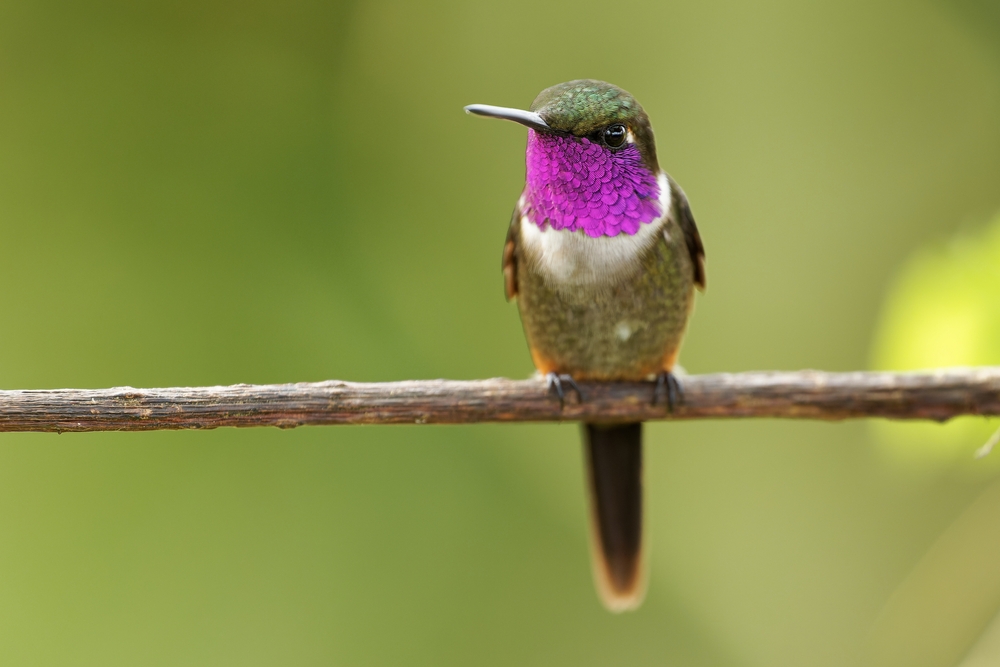Hummingbirds: The Smallest Birds in the World
Posted on Categories Discover Magazine

Europeans had never seen a hummingbird when they first arrived in the Americas. Because of their petite size and vibrant, beautiful coloring, they called the birds Joyas voladoras — flying jewels.
Delicate as they are, they don’t let their small size get in the way of being bold and unique in the animal kingdom. Here are some interesting facts about the world’s favorite J. voldoras.
Types of Hummingbirds
(Credit:Ondrej Prosicky/Shutterstock)
Of the over 330 species of hummingbirds worldwide, they all live in the Western hemisphere. While they are mainly around the equator, these birds can migrate as far north as Canada and Alaska.
According to a 2022 study from Yale University, published in Communications Biology, these iridescent, vibrant birds have more color variety in their plumage than any other bird species combined.
Smallest Bird in the World
(Credit:Lev Frid/Shutterstock) Bee Hummingbird male sitting on branch
While hummingbirds are the most colorful birds in the world, they are also the smallest. Most weigh anywhere from 0.088 to 0.23 ounces and measure about 3 to 5 inches long. The smallest of the small is the bee hummingbird (Mellisuga helenae).
The bee hummingbird is only found in Cuba and weighs between 0.056 and 0.067 ounces, and is about 2 inches long. According to the Audobon Society, the bee hummingbird has a tiny nest, less than an inch across, and lays eggs about the size of coffee beans.
Besides being the most colorful and smallest bird in the world, according to the Gulf Coast Bird Observatory, a hummingbird’s brain makes up about 4.2 percent of its body weight, which is the most significant brain-to-body ratio of any bird.
Hummingbirds Wings
(Credit:Sue Bishop/Shutterstock)
Ever wonder how hummingbirds got their name? It’s from the humming sound their wings make as they fly. According to American Bird Conservancy (ABC), hummingbirds’ wings beat 60 to 80 times per second. Thanks to a flexible shoulder joint, their wings can rotate 180 degrees, allowing them to fly up, down, backward and forward, and hover in mid-air.
Though they can easily maneuver through the air, one thing they can’t do is walk like many other bird species. They can use their tiny feet to shuffle sideways on branches, but other than that, their feet are only used for perching. However, according to ABC, they need small feet to help them stay aerodynamic.
Because of their fast wings, a rapid heartbeat and tiny feet, they can fly up to 20 to 30 miles per hour. The Anna’s hummingbird can even reach speeds of 60 miles per hour.
What Do Hummingbirds Eat?
(Credit:Roman Teteruk/Shutterstock)
Hummingbirds may be tiny, but they have a big appetite, and for good reason. They have a high metabolism, and according to a 2005 study published in Nutrition Journal, they can have heart rates of up to 1260 beats per minute and breathing rates of 250 breaths per minute.
To keep their tiny wings moving fast through the night, they need to consume a lot of nectar or insects throughout the day. According to the National Park Service, some hummingbirds must eat half their body weight in nectar and bugs to avoid starvation.
Hummingbirds drink nectar from flowers using their specially adapted tongues. Initially, researchers believed that they used their tongues like a siphon to drink nectar. However, using high-speed cameras, researchers and ornithologist Alejandro Rico-Guevara found that hummingbird tongues act more like a pump.
As the hummingbird draws the nectar back to its mouth, the beak slightly presses down on the tongue from the top and bottom, allowing the nectar to flow into the its awaiting belly.
Read More: Hummingbird Tongues Act Like Tiny Pumps